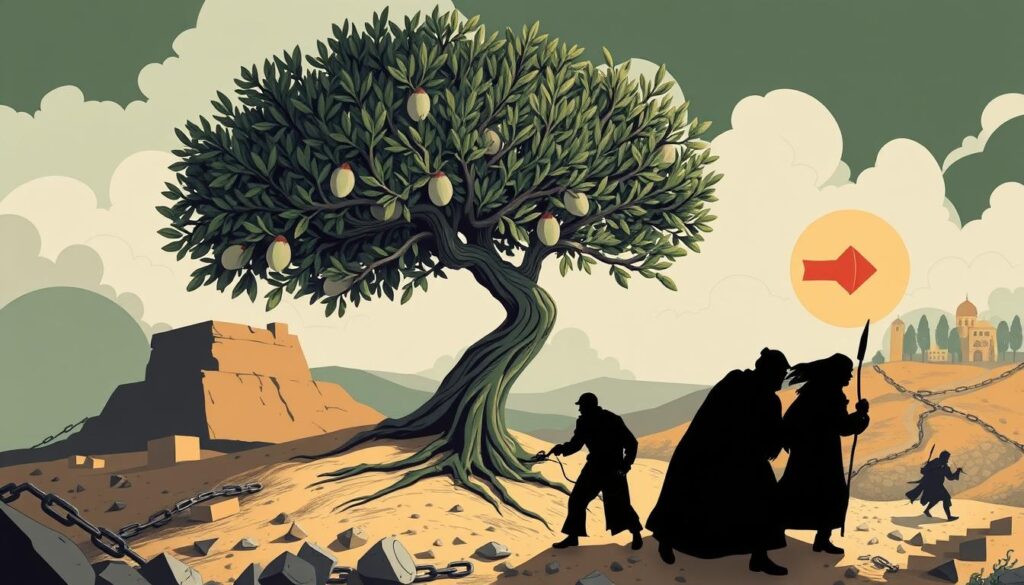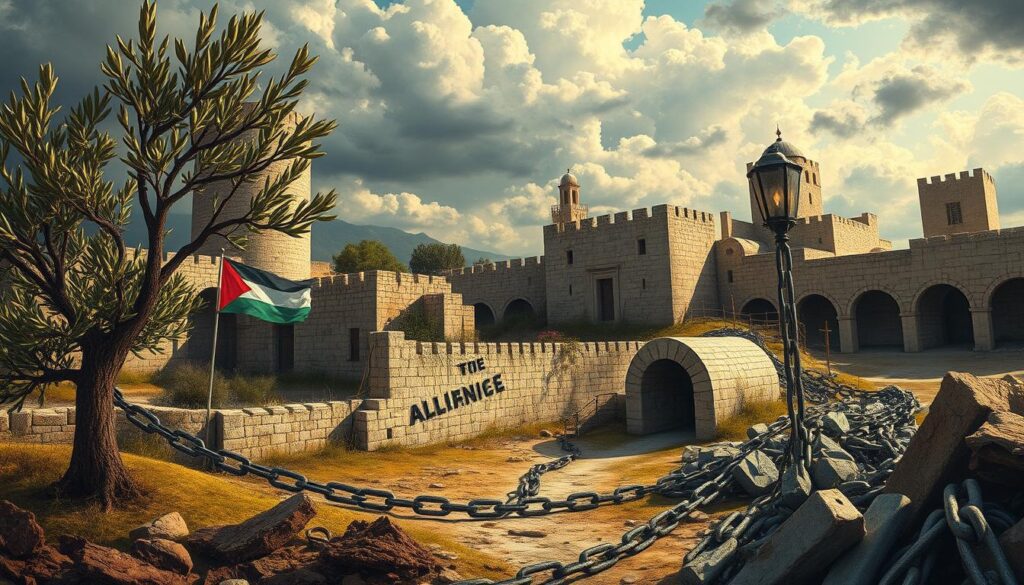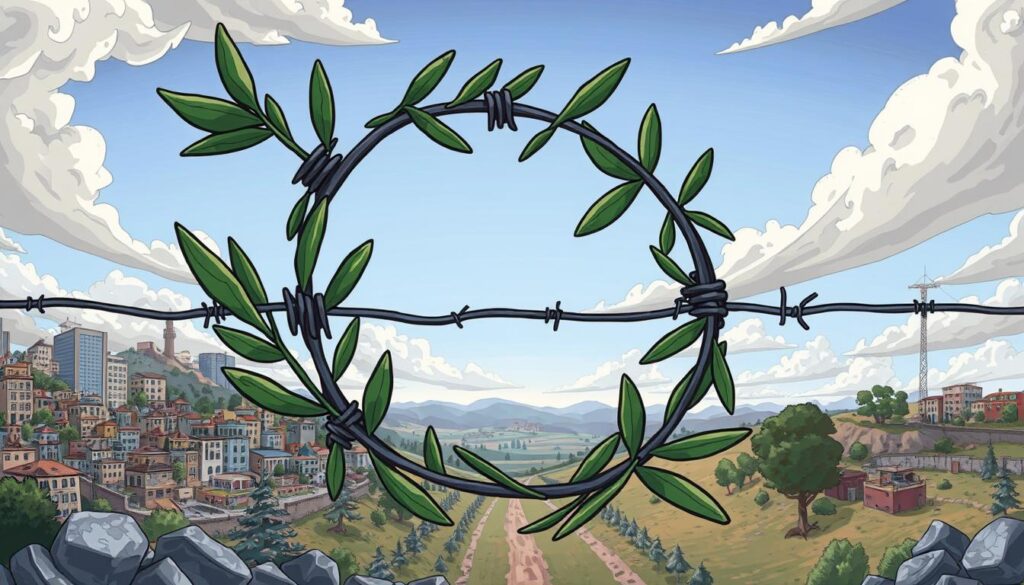
Political Cartoons About Palestine: Visual Commentary
Political cartoons are a robust manner to talk approximately the Israeli-Palestinian war. They display different perspectives in a unique manner. This facilitates us recognize the Middle East’s complicated politics.
Cartoonists use satire and criticism to make their factor. They display us how to think about this long-standing trouble. This manner, they help shape what we talk about in public.
Looking at political cartoons about Palestine suggests how they have changed. They mirror changes in politics and the fight for justice. We explore their history, symbols, and the importance of free speech.
This facilitates us see how cartoons have always played a huge role. They assist us understand the Israeli-Palestinian battle and its huge consequences.

Key Takeaways
- Political cartoons serve as a powerful medium for visual commentary on the Israeli-Palestinian conflict.
- Cartoonists use satire and criticism to shape public discourse around complex geopolitical issues.
- Historical context and the evolving landscape of Middle East politics are crucial to understanding the significance of these editorial illustrations.
- The role of freedom of expression and censorship is a crucial aspect in the creation and dissemination of political cartoons.
- Analyzing the visual rhetoric and symbolism in these cartoons offers unique insights into the perspectives and biases shaping the conflict.
The Power of Satire in Political Cartoons
Political cartoons are a robust device for commenting on society and politics. They use satire to focus on vital troubles. This art form has greatly motivated how we talk approximately the Israeli-Palestinian conflict. We observe its history and the way artists balance free speech with censorship.
Historical Context and Significance
Political cartoons have been used for critique since the 18th century. They assist artists undertaking the present day kingdom of things. In the Israeli-Palestinian struggle, they provide a unique view of a complex trouble.
Freedom of Expression and Censorship
Cartoonists face a difficult choice among speakme freely and avoiding censorship. Free speech is prime in democracies, however cartoons can on occasion face censorship. Artists have to weigh their creativity against feasible backlash.
Despite those hurdles, satire in cartoons is essential for public debate. It makes use of pix to show hypocrisy, task common views, and spotlight marginalized voices. This helps us understand the Israeli-Palestinian battle and international politics better.
Read More New: Political Cartoons About Palestine: Visual Commentary

| Characteristic | Freedom of Expression | Censorship |
|---|---|---|
| Legal Framework | Enshrined in constitutional rights and international human rights treaties | Justified by national security, public order, or moral concerns |
| Artistic Expression | Allows for creative, critical, and satirical depictions of political issues | Imposes restrictions on the content and publication of political cartoons |
| Public Discourse | Facilitates open debate and diverse perspectives on contentious topics | Limits the range of opinions and narratives presented to the public |
“Political cartoons have the power to challenge the status quo, expose hypocrisy, and give voice to those who might otherwise be marginalized. In a world of increasing polarization, this medium remains a vital tool for fostering dialogue and understanding.”
Analyzing Visual Rhetoric in Palestine Cartoons
Political cartoons about Palestine are a sturdy manner to proportion views. They use artwork to speak about the Israeli-Palestinian battle. These cartoons use symbols and metaphors to make people think and speak.
Symbolism is big in Palestine cartoons. Cartoonists use symbols just like the olive department and the keffiyeh headscarf. These symbols help humans speedy get the main points.
Metaphors are also key. Cartoons may display the warfare as a scale or a wall. These pics help us see the war’s complexity and energy balance.
Looking at visible rhetoric in Palestine cartoons facilitates us understand how artists touch upon the conflict. These cartoons are a sturdy manner to begin conversations and make us think deeply about this complicated difficulty.
| Visual Rhetorical Device | Example in Palestine Cartoons | Significance |
|---|---|---|
| Symbolism | Olive branch, Star of David, Palestinian keffiyeh | Represent different sides or aspects of the conflict |
| Metaphor | Scale balancing interests, Wall dividing sides | Convey complexities and power dynamics in the conflict |

“Political cartoons about Palestine are a powerful medium for visual rhetoric, employing a range of artistic techniques to convey complex messages about the Israeli-Palestinian conflict.”
Political Cartoons About Palestine: Exploring the Israeli-Palestinian Conflict Through Art
Political cartoons approximately Palestine provide a unique manner to study the israeli-palestinian battle. They use symbols and metaphors to make complex issues easy. This makes it easier to apprehend the coronary heart of the dispute.
Symbolism and Metaphors in Editorial Cartoons
Editorial cartoons use symbols to talk approximately energy, struggles, and human emotions inside the israeli-palestinian conflict. For instance, they often display Israel as a massive, robust parent over a small, vulnerable Palestinian. This suggests the power distinction between the two.
In palestinian cartoons, symbols just like the olive tree and the important thing are commonplace. The olive tree stands for the Palestinian human beings’s deep connection to their land. The key way the proper of go back for folks who had to depart. These symbols assist inform complex tales in a simple manner.
“Political cartoons have the power to distill complex geopolitical issues into powerful visual statements that resonate with audiences worldwide.”
The use of symbolism and metaphors in editorial cartoons about Palestine we could cartoonists reach human beings all around the global. They connect with emotions all of us proportion. This can exchange how humans see the israeli-palestinian warfare.

Middle East Politics and International Relations
Political cartoons approximately Palestine display the Israeli-Palestinian battle’s complexity. They also spotlight the Middle East’s wider political scene. It’s key to peer how those cartoons hyperlink to global politics, power, and propaganda.
Propaganda Analysis and Bias
Political cartoons aim to sway public views and form tales. In the Middle East, they often replicate exclusive agendas and ideals. We need to observe those cartoons carefully, spotting propaganda and bias.
By reading the symbols, metaphors, and messages in those cartoons, we learn more approximately the Middle East’s complex politics. This allows us apprehend the numerous perspectives and electricity systems. It ends in a deeper, extra balanced view of the issues.
- Explore how political cartoons may reflect or amplify certain narratives about the Middle East conflict
- Identify potential biases and propaganda tactics used in these visual commentaries
- Understand the broader geopolitical implications and power dynamics that shape the discourse around the Israeli-Palestinian conflict
“Political cartoons can be a powerful tool for commentary, but they can also be used to manipulate and distort the truth. It’s essential that we approach these visual representations with a critical eye and an understanding of the broader context in which they are created.”
By looking into Middle East politics, global relations, and propaganda, we get a full picture. We see how political cartoons shape public views and global opinions.
The Role of Cartoonists in Shaping Public Opinion
Political cartoonists have a huge impact on how we reflect onconsideration on massive problems just like the Israeli-Palestinian battle. They make complicated thoughts simple and effective. This helps begin conversations, question what we recognize, and encourages us to get concerned in world activities.
Political cartoons are excellent at sharing huge thoughts in a brief and meaningful way. They use symbols, metaphors, and jokes to seize our attention. This is particularly true for the Israeli-Palestinian battle. Cartoons assist specific confrontation, criticize actions, and help us apprehend the info.
Also, the freedom to create that cartoonists have suggests how critical they may be. They watch over society, query the status quo, and supply a voice to folks who are regularly unnoticed. Their work not simplest educates however additionally motivates us to assume deeply about international politics and international members of the family.
FAQ
What is the historical significance of political cartoons about Palestine?
Political cartoons have been around since the 18th century. They are used to comment on social and political issues. In the Israeli-Palestinian conflict, they play a big role in shaping public opinion.
Cartoonists use satire and symbols to make complex issues simple. This sparks important conversations and challenges common views.
How do political cartoons about Palestine leverage visual rhetoric to convey their messages?
Cartoons about Palestine use symbols and metaphors to talk about the conflict. They make complex issues simple and thought-provoking. This encourages people to think deeply about the Israeli-Palestinian dispute.
What role does freedom of expression play in the creation and dissemination of political cartoons about Palestine?
Cartoonists need freedom to share their views on the conflict. But, there’s a fine line between free speech and censorship. Some cartoons face backlash or censorship.
It’s important to understand this balance. It helps us see how cartoons shape public opinion on Middle East politics.
How do political cartoons about Palestine intersect with broader geopolitical dynamics in the Middle East?
Cartoons about Palestine reflect the Israeli-Palestinian conflict and the Middle East’s larger politics. They touch on international relations and power struggles. This gives us a deeper understanding of the region’s complexities.
What is the enduring legacy of political cartoons in shaping public opinion on the Israeli-Palestinian conflict?
Cartoonists have a big impact on public opinion, especially on complex issues like the Israeli-Palestinian conflict. They make complex ideas simple and powerful. This sparks important conversations and empowers people to engage with global issues.
The legacy of cartoons is their ability to inform, provoke, and inspire. They are key to understanding and addressing Middle East tensions.




